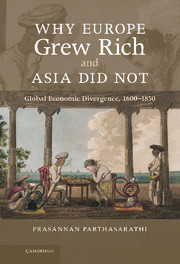Book contents
- Frontmatter
- Contents
- Figures
- Maps
- Tables
- Acknowledgments
- Abbreviations
- Maps
- Chapter 1 Introduction
- Part I Setting the stage: Europe and Asia before divergence
- Part II The divergence of Britain
- Chapter 4 The European response to Indian cottons
- Chapter 5 State and market: Britain, France and the Ottoman Empire
- Chapter 6 From cotton to coal
- Part III The Indian path
- Notes to the text
- Bibliography
- Index
Chapter 4 - The European response to Indian cottons
Published online by Cambridge University Press: 07 September 2011
- Frontmatter
- Contents
- Figures
- Maps
- Tables
- Acknowledgments
- Abbreviations
- Maps
- Chapter 1 Introduction
- Part I Setting the stage: Europe and Asia before divergence
- Part II The divergence of Britain
- Chapter 4 The European response to Indian cottons
- Chapter 5 State and market: Britain, France and the Ottoman Empire
- Chapter 6 From cotton to coal
- Part III The Indian path
- Notes to the text
- Bibliography
- Index
Summary
Introduction
In the late seventeenth century consumers in Europe embraced the cotton textiles of India for their beauty, convenience and fashionability. European cloth manufacturers were less welcoming as they saw the Indian goods as a threat to their livelihoods and in many parts of Europe agitations were launched to block imports from the subcontinent, virtually all of which succeeded. Antipathy to Indian cottons was not the only response of European textile manufacturers, however. From the late seventeenth century, opposition to Indian goods was accompanied by efforts to imitate them. In Western, Southern and Central Europe, cloth printers set up shop with linen cloth from Europe or plain white calicoes from India and attempted to reproduce the chintzes that were so characteristic of the subcontinent. The growing demand for cotton fabrics led spinners and weavers to work with the unfamiliar fiber of the cotton plant to create the wide variety of plain, striped and checked cloths that were so desired in Europe, West Africa and the Americas. At times, the silk and wool opponents of Indian imports turned their fury upon local manufacturers who from the eighteenth century were slowly taking over markets with their new cotton goods.
- Type
- Chapter
- Information
- Why Europe Grew Rich and Asia Did NotGlobal Economic Divergence, 1600–1850, pp. 89 - 114Publisher: Cambridge University PressPrint publication year: 2011
- 2
- Cited by

